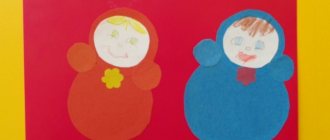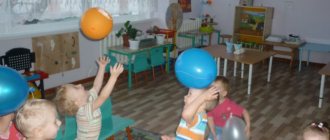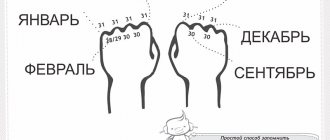Many parents often wonder at what age to send their child to kindergarten, what groups are there in public kindergartens and what is the fundamental difference between them.
Depending on the age, the child will fall into one group or another. There are 5 age groups in public kindergartens.
- A short-term stay group is open for children 1-3 years old;
- children from 3 to 4 years old fall into the younger age group;
- The middle group includes children 4-5 years old;
- the senior group is attended by children aged five and six;
- and boys and girls aged 6 and 7 years old go to the preparatory group.
Nursery
The youngest pupils are accepted into the nursery group of the kindergarten. Their age ranges from 1 year to 2-3 years. They are usually located on the ground floor; the furniture in the group corresponds to the height of the children.
Classes are provided on the development of speech, music, and the surrounding world, in accordance with the plan. Classes are conducted by a teacher in a group and last no more than 10 minutes.
Toys are also selected according to age: large cubes and pyramids, rubber animals and baby dolls, balls, cars, children's sets for playing with sand, dolls, doll dishes, baby books - all without small and dangerous parts.
The daily routine in the nursery group differs from that of older children: early breakfast, lunch, afternoon snack, dinner. Going to bed early for a quiet hour.
There should be no more than 10-15 children in such a group. The presence of a nanny is required to help dress and undress the children, feed and wash them, and put them to bed.
There is usually only one holiday - New Year, and it is also celebrated in a group.
Montessori classes to develop a sense of order for children 2-3 years old
Such exercises help the child understand the principles by which our world exists; mainly here we work on sorting and classification.
Find a pair - Montessori classes for 2-3 years old
The principle of pair selection can be very widely used in working with children:
- Invite your child to sort his own socks and gloves.
- Print out images of animals and offer to compare the picture with existing toy models (the same can be done with your favorite cars, flowers, building models, etc.)
- Offer to find paired cards (colors, images, textures),
- Use special Montessori materials for 2 years and older
Sorting – complicated Montessori games for children from 2 years old
When the baby has mastered pairs, you can move on to a more complex option - sorting.
- Sort cards of different shades by color (you can cut pictures from magazines, scraps, colored cardboard, or you can buy a ready-made Montessori set),
- Remember Cinderella and offer to sort out different types of cereals. First, it is better to take larger grains: beans, chickpeas. Children's breakfast cereals with their cereals, pillows and rings can also be convenient,
- Sort out the box with grandma's buttons by shape, color or number of holes (you definitely have one!)
- Ask your child to put the cutlery in its place,
- Offer to clean up the kitchen and put all the cylinders and balls in one direction, and the cubes and parallelepipeds in the other,
- Rewind the salad: cucumbers to cucumbers, tomatoes to tomatoes, and so on
Establishing Montessori Sequences for a Child 3 Years and Under
- Lay out cards with simple stories and ask your child to remember the correct sequence of events.
- Use Montessori cylinders to help your child master the concepts of less-more and lower-higher,
- Learn simple self-care steps, breaking them down into steps. This way you can learn how to brush your teeth, take a shower, care for animals, and get ready for kindergarten.
Junior
The younger group is attended by children aged 3 to 4 years. These are more independent children who know and can do a lot.
Drawing, physical education and music lessons with specialist teachers, drawing and modeling are added to the main classes. The duration of the lesson is 15 minutes.
Children at this age love to play role-playing games, so among the toys there are various, but simple, children's sets of a doctor, a hairdresser, a builder, a cook, as well as all kinds of construction sets with large parts and figures.
Reading books may contain a longer and more detailed plot. There should also be books with riddles and simple coloring books with a simple silhouette or outline.
In the younger group, in addition to the New Year, a holiday dedicated to March 8 is often organized for children, and they are held in a large music hall.
Many children at this age already speak well, so for performances at holidays they can be given poems and small roles to memorize together with their parents.
Junior group. Early childhood, nursery. Children 1-4 years old
Decorative and applied arts in the first junior group (2–3 years). Teamwork
Nellya the hedgehog girl. The teacher had previously prepared the base for the plasticine craft . Together with the children, they stuck cotton swabs into the finished base. Peacock Petya. The teacher prepared the basis for crafts from plasticine . Together with the children , using cotton swabs, they made a tail for a peacock….
Application in the early age group “Decorate the mitten” Summary of GCD APPLICATION in the early age group “Decorate the mitten”
Objectives: Educational: - Reinforce the names of colors
(red, yellow, blue, green, orange)
; - To develop the ability to distribute figures in a certain part of the mitten (top, bottom, middle, in the form of a pattern;...
Average
The age of children in the middle group is from 4 to 5 years. They are already more physically developed, love to play outdoor games, and acquire the first skills in using simple sports equipment (balls, hoops, skittles, gymnastic sticks, etc.). Therefore, in the middle group of kindergarten they conduct much more physical education classes and physical education minutes, including outside.
Classes such as mathematics, literacy, application, and logic are being introduced. Class duration is 20 minutes.
In many kindergartens, parents are given the opportunity to enroll their children in additional clubs - dance, English, arts and crafts, etc.
Toys and games include cubes with complex patterns for making pictures, lotto and dominoes, educational board games, as well as glove toys for acting out theatrical scenes and fairy tales. Children can now not only listen to a fairy tale to the end, but also, having memorized the roles, show it to children of younger groups.
“Autumn Festival” and “Spring Festival” are added to the main matinees.
We sculpt, draw and talk
Children under three years old come to the nursery with different levels of training and development. Therefore, before starting classes, an experienced teacher should help lagging children catch up to the general level.
If the child has not held a pencil in his hand, the teacher’s task is to teach him the basic skills of using a felt-tip pen or pen. Only after this can the baby be taught to use gouache. In drawing lessons, children learn to draw vertical and horizontal lines, draw an oval and a circle.
Activities with plasticine have long become a classic in nurseries and kindergartens - almost all children enjoy such entertainment. In modern nurseries we have gone further - our kids boldly handle clay and dough. In this way, children become familiar with the properties of various objects; during modeling, the baby’s observation, attention and fine motor skills develop.
The most time-consuming task is the development of speech in children. Children learn to compose sentences, reproduce sounds and even poetic rhythms. Children's books and illustrations help make exercise fun, interesting and lively. Such activities should not be tiring, so they alternate with outdoor games, physical exercise and dancing.
Older
The senior group of the kindergarten is attended by children aged 5 to 6 years. Classes are already becoming more intense, in-depth and longer – 25 minutes each.
In addition to the basic ones, classes can be held on the history of the native land and basic handicraft skills can be instilled.
Children can already perform simple exercises from sports such as gymnastics, basketball and some others.
The toys in the group should be varied and age-appropriate: mosaics, puzzles, three-dimensional construction sets with many details.
Children are also taught housekeeping skills. Therefore, among the toys there should be miniature doll gas stoves, cutlery, an ironing board with a toy iron, brooms, dustpans and brooms. You can invite children to care for indoor flowers, aquarium fish, and parrots.
“Christmas”, “Defender of the Fatherland Day”, “Easter”, “Victory Day” are added to holidays and matinees.
Preparatory
The preparatory group of the kindergarten is attended by children aged 6 to 7 years. For children, this is a very important, last, final stage before entering school.
There are many developmental and educational activities: reading and mathematics, native speech and the world around us, music and physical education, manual labor and origami, modeling and drawing.
The group often sets up easels and hangers with clothes from various professions for children’s story games. At this age, children are actively learning the rules of etiquette, as well as traffic rules.
Matinees and holidays are elaborate and theatrical. Children can even act as presenters. The graduation party at the end of the year is the most important for children and their parents, where graduates show all their abilities and talents.
Peculiarities of development of children of the second junior group of kindergarten
Klyukina Irina
Peculiarities of development of children of the second junior group of kindergarten
The 2nd junior group of kindergarten is designed for children aged 3-4 years . At this age, many skills continue to be actively formed in children mental processes, such as speech, thinking, and memory, actively develop Therefore, to a large extent, how all these processes proceed will in the future affect the child’s level of readiness for school. Kindergarten is rightfully considered the second social institution in a child’s life after the family, in which completely different social norms and relationships reign, unfamiliar to him before. During the period of preschool education, a child needs to learn, understand, learn, recognize, and comprehend a lot. First of all, children in kindergarten learn to communicate and be in a team, learn the rules of ethical behavior and communication with peers. It is worth noting that educators play a primary role in this process.
At this age children develop self-esteem, they try to meet the demands of adults, learn to be good and obedient, and to contrast and compare themselves with other children. But sometimes the conclusions from such a contrast are incorrect, especially if the child has not established contact in the team or with teachers, which later manifests itself in outbreaks of aggression, reluctance to attend kindergarten , stubbornness, whims, and even hysterics. Taking this nuance into account, psychologists tend to consider children of the 2nd junior group of kindergarten as children who are in a transitional and crisis age. The task of educators and parents, through joint efforts, is to help children safely cross this age limit. Through changes in mental processes such as perception, attention, imagination, speech, thinking, memory, the child’s character and temperament continue to form, and activities improve. If for children the needs for guardianship, love, care and affection came first, now priorities change somewhat, and approval of actions, praise, independence, support and recognition come to the fore. The child feels the need for independence, and begins to show it in different ways, seeing the approval of adults from the outside, in the form of praise or other rewards, he feels a sense of pride. Therefore, do not forget to praise your child for any, no matter how small, achievement.
Children in the 2nd junior group of kindergarten have a significant desire for cognitive activity. Therefore, this age is also called the age of “why”
.
Sometimes educators and parents are bombarded with a hail of children’s questions, and this is very good. After all, if a child is interested in something, the information he receives in the form of an answer will probably be remembered for a long time and will add to his treasury of knowledge and experience. Various kinds of excursions, performances and holidays, which are organized in a group , have a beneficial effect on children .
The 2nd junior group of the kindergarten are children who already know a lot when compared with the nursery group of the kindergarten . A significant difference can be clearly seen not only in external signs, children’s , their behavior in a group, but also in the classroom. Progress is noticeable, but in order to clearly determine the level of development of the child and the compliance of this level with general norms, it was invented to conduct psychodiagnostics of children . Such tests help identify gaps that most children , with the further goal of eliminating them. To begin with, children of the 2nd junior group of kindergarten are asked to take the Beni-Simon test. Based on this test, a child aged 3-4 years should be able to say his first and last name, be able to repeat from memory a short sentence read to him, as well as any two numbers, answer who is drawn in the pictures shown to him, and also know and be able to show , where his nose, ears, hands, eyes are located. This small test shows the child's level of mental development . At the second stage, they check the child’s of development And only after that they make a conclusion about the child’s level of development in accordance with age standards, based on the number of correct answers and the time they were completed.
Thus, the task of the kindergarten , as an organization of preschool education, is to promote the further physical, emotional, creative, intellectual and volitional development of preschool children.
Speech therapy
Children are recruited into speech therapy groups by a speech therapist based on preliminary testing and after a thorough examination. The ONR group includes children with general speech disorders, the FNR group includes children with problems in pronouncing certain sounds.
Pupils, in addition to the main classes, engage in special exercises with a speech therapist and teacher aimed at improving and improving their speech.
In such groups there are usually not many children - 10-12 people. Classes with a speech therapist can be individual or group, and are conducted according to a schedule. All other classes are conducted according to a simplified and facilitated plan, acceptable for children with such defects.
Meals in the nursery group
Babies in the nursery are fed 4 times - breakfast, lunch, after a nap, an afternoon snack and dinner. Breakfast usually consists of light dishes: casseroles, cottage cheese soufflés, milk porridge, omelet, vegetable salad (necessarily fresh), a warmed drink. Lunch for children consists of vegetarian soups, steamed meat dishes or boiled fish with side dishes of mashed potatoes or cereals. Daily fortified drinks, such as compote or jelly, are required. Since these are very young children, the menu should be as suitable as possible for all children because not all children adapt equally well and quickly to the new conditions of the nursery. For dinner, children are offered vegetable stew, beet and carrot caviar, vegetable casserole, and puddings. In addition to the meal, they provide sour milk products, fresh fruits, and juices.
Summer
A summer group is usually a temporary group for the summer period, which is attended by children of different ages. There are usually no classes in the summer, but only outdoor games, reading books, going to puppet theaters or museums.
In any group of a preschool institution there must be two teachers and one nanny.
The day should be organized strictly according to the regime established for each specific age, with games, walks, activities, and entertainment. Each lesson is held no more than 2 times a week.
Specialized groups
The division of children in preschool educational institutions is carried out not only by age, but also by purpose and nature of stay.
The mental characteristics and physiological state of the child are also taken into account. Today, the following specialized groups operate in Russian kindergartens:
- GKP or short-term stay . They are rare in preschool educational institutions. They are intended for those children whose parents are not yet ready to leave for the whole day. As a rule, such a group includes no more than 15 people. This allows you to implement an individual approach to the development of the baby. In some kindergartens, the GKP is combined with a regular group;
- speech therapy Suitable for children who have problems with pronunciation. Speech therapists work with the children. The purpose of the classes is to correct speech defects and enrich vocabulary;
- for children with disabilities . The group is distinguished by its heterogeneity. It is attended by children with visual and hearing impairments, and problems with the musculoskeletal system. Children with developmental delays and various emotional disorders are also included here. Specialists work with children to help them eliminate the disorder and acquire the necessary level of knowledge;
- summer _ This is a multi-age temporary group of preschool educational institutions. Created for the summer. The emphasis is on entertainment rather than education. Hiking, outdoor games, and excursions are organized for children.




